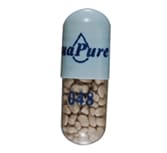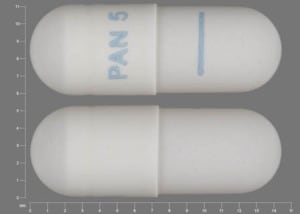Dosage Forms
Excipient information presented when available (limited, particularly for generics); consult specific product labeling.
Capsule, delayed release, bicarbonate buffered enteric coated microspheres, oral [porcine derived]:
Pertzye: Lipase 4,000 USP units, protease 14,375 USP units, and amylase 15,125 USP units
Pertzye: Lipase 8,000 USP units, protease 28,750 USP units, and amylase 30,250 USP units
Pertzye: Lipase 16,000 USP units, protease 57,500 USP units, and amylase 60,500 USP units
Pertzye: Lipase 24,000 USP units, protease 86,250 USP units, and amylase 90,750 USP units
Capsule, delayed release, enteric-coated beads, oral [porcine derived]:
Zenpep: Lipase 3,000 USP units, protease 10,000 USP units, and amylase 14,000 USP units
Zenpep: Lipase 5,000 USP units, protease 17,000 USP units, and amylase 24,000 USP units
Zenpep: Lipase 10,000 USP units, protease 32,000 USP units, and amylase 42,000 USP units
Zenpep: Lipase 15,000 USP units, protease 47,000 USP units, and amylase 63,000 USP units
Zenpep: Lipase 20,000 USP units, protease 63,000 USP units, and amylase 84,000 USP units
Zenpep: Lipase 25,000 USP units, protease 79,000 USP units, and amylase 105,000 USP units
Zenpep: Lipase 40,000 USP units, protease 126,000 USP units, and amylase 168,000 USP units
Zenpep: Lipase 40,000 USP units, protease 136,000 USP units, and amylase 218,000 USP units [DSC]
Capsule, delayed release, enteric coated microspheres, oral [porcine derived]:
Creon: Lipase 3000 USP units, protease 9500 USP units, and amylase 15,000 USP units
Creon: Lipase 6000 USP units, protease 19,000 USP units, and amylase 30,000 USP units
Creon: Lipase 12,000 USP units, protease 38,000 USP units, and amylase 60,000 USP units
Creon: Lipase 24,000 USP units, protease 76,000 USP units, and amylase 120,000 USP units
Creon: Lipase 36,000 USP units, protease 114,000 USP units, and amylase 180,000 USP units
Capsule, delayed release, enteric coated microtablets, oral [porcine derived]:
Pancreaze: Lipase 2600 USP units, protease 6200 USP units, and amylase 10,850 USP units
Pancreaze: Lipase 4200 USP units, protease 14,200 USP units, and amylase 24,600 USP units
Pancreaze: Lipase 10,500 USP units, protease 35,500 USP units, and amylase 61,500 USP units
Pancreaze: Lipase 16,800 USP units, protease 56,800 USP units, and amylase 98,400 USP units
Pancreaze: Lipase 21,000 USP units, protease 54,700 USP units, and amylase 83,900 USP units
Tablet, oral [porcine derived]:
Viokace: Lipase 10,440 USP units, protease 39,150 USP units, and amylase 39,150 USP units
Viokace: Lipase 20,880 USP units, protease 78,300 USP units, and amylase 78,300 USP units
Pharmacology
Mechanism of Action
Pancrelipase is a natural product harvested from the porcine pancreatic glands. It contains a combination of lipase, amylase, and protease. Products are formulated to dissolve in the more basic pH of the duodenum so that they may act locally to break down fats, protein, and starch.
Pharmacokinetics/Pharmacodynamics
Absorption
None; acts locally in GI tract
Excretion
Feces
Use: Labeled Indications
Pancreatic insufficiency (exocrine): Treatment of exocrine pancreatic insufficiency caused by cystic fibrosis or other conditions. Creon is also approved for patients with chronic pancreatitis or pancreatectomy. Viokace, in combination with a proton-pump inhibitor, is approved for use in adults with exocrine pancreatic insufficiency caused by chronic pancreatitis or pancreatectomy.
Note: Viokace must be administered with a proton pump inhibitor (PPI) since it is not enteric coated.
Contraindications
There are no contraindications listed in the US labeling.
Canadian labeling: Hypersensitivity to pancrelipase or any component of the formulation; acute pancreatitis; acute exacerbation of chronic pancreatitis.
Dosage and Administration
Dosing: Adult
Note: Dosing should not exceed recommended maximum dosage set forth by the Cystic Fibrosis Foundation Consensus Conferences Guidelines. Adjust dose based on body weight, clinical symptoms, stool fat content, and the fat content of the diet. Allow several days between dose adjustments. Total daily dose reflects ~3 meals per day and 2 to 3 snacks per day, with half the mealtime dose given with a snack. Doses of lipase >2,500 units/kg/meal, lipase >10,000 units/kg/day, or lipase >4,000 units/g fat daily should be used with caution and only with documentation of effectiveness by 3-day fecal fat measures indicating a significantly improved coefficient of fat absorption. Doses of lipase >6,000 units/kg/meal are associated with colonic stricture and should be decreased.
Pancreatic insufficiency due to conditions such as cystic fibrosis: Oral (Creon, Pancreaze, Pertzye, Ultresa, Zenpep): Initial: Lipase 500 units/kg/meal. Dosage range: Lipase 500 to 2,500 units/kg/meal. Maximum: Lipase ≤2,500 units/kg/meal or lipase ≤10,000 units/kg/day or lipase <4,000 units/g of fat daily
Pancreatic insufficiency due to chronic pancreatitis or pancreatectomy: Oral:
Creon: Initial: Lipase 500 units/kg/meal with individualized dosage titrations. In one clinical trial, 72,000 units/meal while consuming ≥100 g of fat daily was used. Usually, half the prescribed dose for an individualized full meal should be given with each snack. Maximum: Lipase ≤2,500 units/kg/meal or lipase ≤10,000 units/kg/day or lipase <4,000 units/g of fat daily
Viokace (administer in combination with a proton pump inhibitor): Initial: Lipase 500 units/kg/meal with individualized dosage titration. In one clinical trial, 125,280 units/meal while consuming ≥100 g of fat daily was used. Usually, half the prescribed dose for an individualized full meal should be given with each snack. Maximum: Lipase ≤2,500 units/kg/meal or lipase ≤10,000 units/kg/day or lipase <4,000 units/g of fat daily.
Pancreatic insufficiency (exocrine) due to pancreatic cancer (off-label dosing): Oral: Initial: 25,000 to 50,000 units (lipase) per meal or 1,000 units (lipase)/kg/day or 4,000 units/5 to 7 g fat at each meal; escalate dose based on relief of symptoms; maximum dose: 2,500 units (lipase)/kg/meal (Damerla 2008).
Dosing: Geriatric
Refer to adult dosing.
Dosing: Pediatric
Note: Adjust dose based on body weight, clinical symptoms, and stool fat content. Allow several days between dose adjustments. Total daily dose reflects ~3 meals/day and 2 to 3 snacks/day, with half the mealtime dose given with a snack. Doses of lipase >2,500 units/kg/meal should be used with caution and only with documentation of 3-day fecal fat measures. Doses of lipase >6,000 units/kg/meal are associated with colonic stricture and should be decreased.
Pancreatic insufficiency due to cystic fibrosis:
General dosing recommendations:
Infants: Oral: Lipase 2,000 to 5,000 units per feeding of formula, breast milk, or per breastfeeding. Maximum daily dose: Lipase 10,000 units/kg/day up to 2,500 units/kg/feeding (Borowitz 2009). Note: A review of data from the CF Foundation Patient Registry suggests that the maximum daily dose may be insufficient in young infants with CF; however, the optimal dose is not established (Borowitz 2013).
Children 1 to <2 years: Note: Dosage requirements may fluctuate as diet transitions to more solid foods. Oral: Initial dose: Lipase 1,000 units/kg/meal. Dosage range: Lipase 1,000 to 2,500 units/kg/meal. Maximum daily dose: Lipase 10,000 units/kg/day or lipase 4,000 units/g of fat/day. Higher dosing similar to infant dosing (Lipase: 2,000 to 5,000 units per feeding of formula, breast milk, or per breastfeeding) may be necessary in some patients (Borowitz 2009).
Children ≥2 to <4 years: Oral: Initial dose: Lipase 1,000 units/kg/meal. Dosage range: Lipase 1,000 to 2,500 units/kg/meal. Maximum daily dose: Lipase 10,000 units/kg/day or lipase 4,000 units/g of fat/day.
Children ≥4 years and Adolescents: Oral: Initial dose: Lipase 500 units/kg/meal. Dosage range: Lipase 500 to 2,500 units/kg/meal. Maximum daily dose: Lipase 10,000 units/kg/day or lipase 4,000 units per g of fat/day.
Pancreatic enzyme supplementation, enteral tube feedings: Infants, Children, and Adolescents: Limited data available: Note: With low-fat or elemental enteral formulas, pancreatic enzyme supplementation may not be necessary (Ferrie 2011).
Continuous enteral feeding: Oral: Lipase 1,000 units/g of fat provided by the daily amount of feeds administered in divided doses every 2 to 3 hours (Ferrie 2011)
Overnight enteral feeding: Oral: Administer premeal dose at beginning of feeding; additional dose may be given midway through or at the end of a feeding (Borowitz 2002). Some centers recommend using 1,000 units/g of fat provided by the overnight feed administered in 2 divided doses with the first dose as 50% of requirement or enough to cover 3 hours of feeds and the additional dose given if patient awakens at night or at the end of a feeding (Ferrie 2011).
Administration
Administer with meals or snacks and swallow whole with a generous amount of liquid. Do not crush or chew; retention in the mouth before swallowing may cause mucosal irritation. Usually half the prescribed dose for an individualized full meal should be given with each snack. The total daily dose should reflect approximately 3 meals plus 2 or 3 snacks per day.
Capsules, delayed release: If necessary, capsules may be opened and contents added to a small amount (approximately 10 mL) of soft acidic food (pH ≤4.5), such as applesauce; do not crush microspheres when mixing. The food should be swallowed immediately after mixing; do not chew. The food should be at room temperature (Creon, Ultresa). Follow with water or juice to ensure complete ingestion and that no medication remains in the mouth.
Tablets: Viokace: Tablets are not enteric coated and should be taken with a proton pump inhibitor.
Administration via gastrostomy (G) tube:
Creon: An in vitro study demonstrated that Creon delayed-release capsules sprinkled onto a small amount of baby food (pH <4.5; applesauce or bananas manufactured by both Gerber and Beech-Nut) stirred gently and after 15 minutes was administered through the following G-tubes without significant loss of lipase activity: Kimberly-Clark MIC Bolus size 18 French, Kimberly-Clark MIC-KEY size 16 French, Bard Tri-Funnel size 18 French, and Bard Button size 18 French (Shlieout 2011).
Pertzye: May administer up to two 4,000 unit capsules via G-tube with a diameter of 14 French or larger diameter tube. Thoroughly mix contents of one or two 4,000 unit capsules in ≥10 mL applesauce to create a uniform suspension; do not crush microspheres. Administer via a 35 mL slip tip syringe; flush with ~10 mL of water. Administer immediately after mixing; do not save for later use. If dose requires > two 4,000 unit capsules, repeat.
Dietary Considerations
Take with meals or snacks and swallow whole with a generous amount of liquid. Capsule contents may be sprinkled on a soft acidic food with pH <4.5. Vitamin supplementation should be per current guidelines for patients with cystic fibrosis.
Storage
Avoid heat. Protect from moisture. After opening, keep the container tightly closed between uses to protect from moisture.
Creon: Store at room temperature up to 25°C (77°F); excursions are permitted between 25°C and 40°C (77°F and 104°F) for ≤30 days. Discard if moisture conditions are >70%. Bottles of 3,000 USP units of lipase must be stored and dispensed in the original container.
Pancreaze: Store at ≤25°C (77°F). Store in the original container.
Pancrelipase: Store at 20°C to 25°C (68°F to 77°F); brief excursions are permitted between 15°C and 40°C (59°F and 104°F).
Pertzye: Store at 20°C to 25°C (68°F to 77°F); excursions are permitted between 15°C and 40°C (59°F and 104°F). Store in the original container.
Ultresa: Store at 20°C to 25°C (68°F to 77°F). Store in the original container.
Viokace: Store at 20°C to 25°C (68°F to 77°F); brief excursions are permitted up to 40°C (104°F) for up to 24 hours.
Zenpep:
Original glass container: Store at 20°C to 25°C (68°F to 77°F); excursions are permitted between 15°C and 40°C (59°F and 104°F).
Repackaged HDPE container: Store at ≤30°C (86°F) for up to 6 months; excursions are permitted between 15°C and 40°C (59°F and 104°F) for ≤30 days.
Pancrelipase Images
Drug Interactions
There are no known significant interactions.
Adverse Reactions
The following adverse reactions were reported in a short-term safety studies; actual frequency varies with different products; adverse events, particularly gastrointestinal events, were often greater with placebo.
>10%:
Central nervous system: Headache (3% to 15%)
Gastrointestinal: Abdominal pain (3% to 18%)
Hematologic & oncologic: Lymphadenopathy (11%)
Infection: Streptococcal infection (beta-hemolytic streptococcus: 11%)
Neuromuscular & skeletal: Neck pain (14%)
Otic: Otalgia (11%)
Respiratory: Nasal congestion (14%)
1% to 10%:
Cardiovascular: Peripheral edema (3%)
Central nervous system: Dizziness (4% to 6%)
Dermatologic: Skin rash (3%)
Endocrine & metabolic: Hyperglycemia (4% to 8%), weight loss (3% to 6%), exacerbation of diabetes mellitus (4%), hypoglycemia (4%)
Gastrointestinal: Dyspepsia (10%), diarrhea (≤10%), flatulence (3% to 9%), choledocholithiasis (7%), pruritus ani (7%), early satiety (6%), vomiting (6%), upper abdominal pain (≤5%), abnormal stools (≤4%)
Hematologic & oncologic: Anemia (3%)
Hepatic: Ascites (3%), hydrocholecystis (3%)
Infection: Viral infection (3%)
Renal: Renal cyst (3%)
Respiratory: Cough (4% to 10%), epistaxis (7%), pharyngolaryngeal pain (7%), nasopharyngitis (4%)
<1%, postmarketing, and/or case reports (reported with various formulations of pancrelipase): Anaphylaxis, asthma, blurred vision, carcinoma (recurrence), constipation, duodenitis, fibrosing colonopathy, gastritis, hyperuricemia, increased serum transaminases (asymptomatic), intestinal obstruction (distal intestinal obstruction syndrome [DIOS]), muscle spasm, myalgia, nausea, neutropenia (transient), pruritus, severe hypersensitivity, urticaria
Warnings/Precautions
Concerns related to adverse effects:
- Fibrosing colonopathy: Fibrosing colonopathy, advancing to colonic strictures, has been reported (rarely). Risk may be increased with high doses, prolonged use, and in pediatric patients with cystic fibrosis; however, the mechanism is unknown. Doses of lipase >6,000 units/kg/meal have been associated with colonic stricture in children <12 years. Patients taking doses of lipase >6,000 units/kg/meal should be examined and the dose decreased. Doses of lipase >2,500 units/kg/meal, lipase >10,000 units/kg/day, or lipase >4,000 units/g fat daily should be used with caution and only with documentation of effectiveness by 3-day fecal fat measures indicating a significantly improved coefficient of fat absorption.
- Hypersensitivity: Severe, allergic reactions (eg anaphylaxis, asthma, hives, pruritus) have rarely been observed; use with caution in patients hypersensitive to pork proteins, taking into consideration the patient's overall clinical needs.
- Mucosal irritation: Crushing or chewing the contents of the capsules or tablets, or mixing the capsule contents with foods outside of product labeling, may cause early release of the enzymes, causing irritation of the oral mucosa and/or loss of enzyme activity. When mixing the contents of capsules with food, the mixture should be swallowed immediately and followed with water or juice to ensure complete ingestion. Pancrelipase should not be mixed in foods with pH >4.5.
- Pork: Products are derived from porcine pancreatic glands. Transmission of porcine viruses, and diseases caused by novel or unidentified viruses, is theoretically a risk; however, testing and/or inactivation or removal of certain viruses, reduces the risk. There have been no cases of transmission of an infectious illness reported.
Disease-related concerns:
- Gout, hyperuricemia: Use caution in patients with gout or hyperuricemia; porcine-derived products contain purines which may increase uric acid concentrations.
- Pancreatic cancer: According to guidelines from the American Society of Clinical Oncology, patients with pancreatic cancer (potentially curable, locally advanced, or metastatic) who experience exocrine pancreatic insufficiency may require pancreatic enzyme replacement therapy to improve digestion and nutrient absorption (Balaban 2016; Khorana 2016; Sohal 2016). A retrospective study in patients with metastatic pancreatic cancer suggests that pancreatic enzyme replacement therapy is underutilized (Landers 2016).
- Renal impairment: Use caution in patients with renal impairment; porcine-derived products contain purines which may increase uric acid concentrations.
Dosage form specific issues:
- Brand interchangeability: Available brand products are not interchangeable.
- Lactose: Viokace tablets may contain lactose; use with caution in patients with lactose intolerance.
Monitoring Parameters
Abdominal symptoms, nutritional intake, weight, growth (in children), stool character, fecal fat
Pregnancy
Pregnancy Risk Factor
C
Pregnancy Considerations
Animal reproduction studies have not been conducted. Nutrition should be optimized in pregnancy; in cystic fibrosis patients with malabsorption, pancreatic enzyme replacement is not considered to cause a risk to the pregnancy.
Patient Education
What is this drug used for?
- It is used to help break down food when the pancreas is not working the right way.
Frequently reported side effects of this drug
- Headache
- Abdominal pain
- Passing gas
- Diarrhea
- Constipation
- Nausea
- Cough
- Sore throat
- Neck pain
- Stuffy nose
- Ear pain
- Heartburn
- Anal irritation
- Dizziness
- Nosebleed
Other side effects of this drug: Talk with your doctor right away if you have any of these signs of:
- Gallstones like pain in the upper right abdominal area, right shoulder area, or between the shoulder blades; yellow skin; or fever with chills.
- Swollen glands
- Joint pain
- Joint swelling
- Mouth irritation
- Tongue irritation
- Fibrosing colonopathy like abnormal or severe abdominal pain; bloating; difficulty passing stools; nausea; vomiting; or diarrhea.
- Signs of a significant reaction like wheezing; chest tightness; fever; itching; bad cough; blue skin color; seizures; or swelling of face, lips, tongue, or throat.
Note: This is not a comprehensive list of all side effects. Talk to your doctor if you have questions.
Consumer Information Use and Disclaimer: This information should not be used to decide whether or not to take this medicine or any other medicine. Only the healthcare provider has the knowledge and training to decide which medicines are right for a specific patient. This information does not endorse any medicine as safe, effective, or approved for treating any patient or health condition. This is only a brief summary of general information about this medicine. It does NOT include all information about the possible uses, directions, warnings, precautions, interactions, adverse effects, or risks that may apply to this medicine. This information is not specific medical advice and does not replace information you receive from the healthcare provider. You must talk with the healthcare provider for complete information about the risks and benefits of using this medicine.


